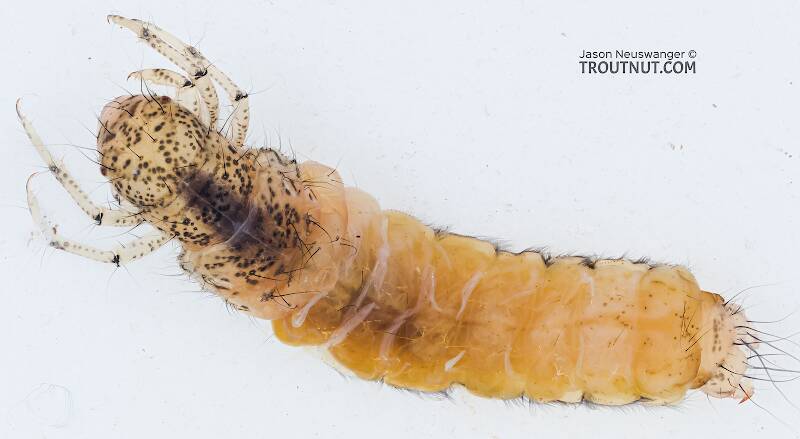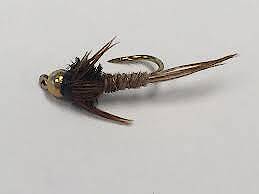
Salmonflies
Pteronarcys californica
The giant Salmonflies of the Western mountains are legendary for their proclivity to elicit consistent dry-fly action and ferocious strikes.
Featured on the forum

This is a striking caddis larva with an interesting color pattern on the head. Here are some characteristics I was able to see under the microscope, but could not easily expose for a picture:
- The prosternal horn is present.
- The mandible is clearly toothed, not formed into a uniform scraper blade.
- The seems to be only 2 major setae on the ventral edge of the hind femur.
- Chloride epithelia seem to be absent from the dorsal side of any abdominal segments.
Based on these characteristics and the ones more easily visible from the pictures, this seems to be Grammotaulius. The key's description of the case is spot-on: "Case cylindrical, made of longitudinally arranged sedge or similar leaves," as is the description of the markings on the head, "Dorsum of head light brownish yellow with numerous discrete, small, dark spots." The spot pattern on the head is a very good match to figure 19.312 of Merritt R.W., Cummins, K.W., and Berg, M.B. (2019). The species ID is based on Grammotaulius betteni being the only species of this genus known in Washington state.
- The prosternal horn is present.
- The mandible is clearly toothed, not formed into a uniform scraper blade.
- The seems to be only 2 major setae on the ventral edge of the hind femur.
- Chloride epithelia seem to be absent from the dorsal side of any abdominal segments.
Based on these characteristics and the ones more easily visible from the pictures, this seems to be Grammotaulius. The key's description of the case is spot-on: "Case cylindrical, made of longitudinally arranged sedge or similar leaves," as is the description of the markings on the head, "Dorsum of head light brownish yellow with numerous discrete, small, dark spots." The spot pattern on the head is a very good match to figure 19.312 of Merritt R.W., Cummins, K.W., and Berg, M.B. (2019). The species ID is based on Grammotaulius betteni being the only species of this genus known in Washington state.

Troutnut is a project started in 2003 by salmonid ecologist Jason "Troutnut" Neuswanger to help anglers and
fly tyers unabashedly embrace the entomological side of the sport. Learn more about Troutnut or
support the project for an enhanced experience here.
Hunter1 on Jun 23, 2020June 23rd, 2020, 6:36 am EDT
Do you use floatant on an emerger fly ? I'm trying them on a dropper dry fly .
Wbranch on Jun 24, 2020June 24th, 2020, 5:09 am EDT
It depends on what the fish are doing if you see head and tail rises it is likely the trout are eating the mayflies as they rise in the water column and they eat them a few inches under the surface. If you see more typical head rises then you can add a little floatant.
Catskill fly fisher for fifty-five years.
Brian314 on Sep 7, 2020September 7th, 2020, 9:45 am EDT
I use that powder floatant on the CDC part of mole flies (a Charlie Craven emerger pattern). The CDC is rather hydrophobic and works well,untreated, at first. But after a while, I find I have to dry the fly and add floatant to the CDC part.
BTW - there's a good tying video on the mole fly at the Orvis nymph-tying page. Brian
BTW - there's a good tying video on the mole fly at the Orvis nymph-tying page. Brian
Quick Reply
Related Discussions
Topic
Replies
Last Reply
Re: So is Ep Infrequens now known as Ep Dorothea?
In the Mayfly Species Ephemerella dorothea infrequens by Wbranch
In the Mayfly Species Ephemerella dorothea infrequens by Wbranch
20
Jul 1, 2014
by Crepuscular
by Crepuscular
4
Jul 8, 2008
by Jjlyon01
by Jjlyon01



